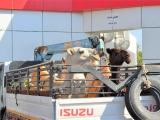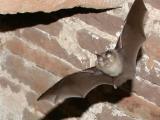Camels have been mentioned as possible sources of a few human cases of the mysterious MERS-CoV (Middle East respiratory syndrome coronavirus), but the World Organization for Animal Health (OIE) said today there is little evidence of such a link.
Meanwhile, the World Health Organization (WHO) yesterday recognized the two latest MERS-CoV cases reported in Saudi Arabia, involving a 41-year-old man and a 59-year-old woman, both of whom are in hospital intensive care units.
The animal source of the virus has remained elusive, but some case-patients were reported to have had contact with camels before they got sick. For example, a German physician said in April that a United Arab Emirates man who was treated for MERS-CoV in Germany had close contact with a sick camel before he fell ill. The man, who was 73 and owned racing camels, died on Mar 26 while being treated in Germany.
But the OIE, in a questions-and-answers press release today, downplayed the notion of a camel connection.
"Currently there is no strong evidence to suggest that camels are a source of infection for human cases of MERS," the agency said. "MERS CoV has not been identified in camels and current information from human cases does not suggest that exposure to camels is an important risk factor. It is important to remain open minded about all potential sources of exposure for human cases until more evidence is available."
Scientists in the United States and the Netherlands, among other countries, are currently testing animal samples in the quest for a MERS-CoV reservoir, but no solid findings have been reported so far.
The OIE said tests of animals should aim to find the virus itself, not just antibodies to it, because serologic (antibody) tests for the virus "have not yet been validated in animals and may not be reliable." The agency said there is a risk of false-positive results because it may not be possible to distinguish antibodies to MERS-CoV from antibodies to other coronaviruses.
No exposures in Saudi cases
In noting the two latest MERS-CoV cases in Saudi Arabia, the WHO said neither patient had any known contacts with other MERS-CoV case-patients or with animals. The statement said both patients had underlying medical conditions, a characteristic they share with many other MERS patients.
The two cases raise the WHO's MERS case count to 90, including 45 deaths.
The WHO did not offer any new travel-related recommendations in yesterday's statement. Last week the agency promised it would issue such recommendations soon, a pledge that followed the conclusion by a special WHO advisory committee that MERS did not yet constitute a public health emergency of international concern.
In other developments, the European Centre for Disease Prevention and Control (ECDC) has concluded that the risk of importation of MERS cases to the European Union remains the same, with sporadic imported cases likely to continue, according to an updated risk assessment dated Jul 19.
Imported cases have surfaced this year in the United Kingdom, France, and Italy, and a few patients have been flown from the Middle East to Germany for treatment. In the UK, France, and Italy, the disease spread to a few other people but sparked no ongoing transmission.
"The risk of secondary transmission in the EU remains low and could be reduced further through screening for exposure among patients presenting with respiratory symptoms and their contacts, and strict implementation of infection prevention and control measures for patients under investigation," the ECDC said.
In other observations, the agency offered a possible partial explanation for the finding that most MERS patients have been male and on the older side: Saudi Arabia, where most of the cases have occurred, has more men than women.
"It is important to note that there are more men than women in the Saudi population," with a male:female ratio of 1.21:1, "and that this skewed sex distribution is most accentuated in 25-54-year age group (M:F 1.36)," the agency said, adding, "It is possible that gender based care-seeking and care-receiving behaviour in the Middle East plays a role."
The sex and age distribution of patients has changed some in recent weeks, with contact investigations finding more cases in women and younger people. But the ECDC said that among the 88 cases confirmed as of last week, 62% were in males and the median age was 51.
Potential for airborne transmission
In other recent developments, an international team of researchers estimated that in the peak months for Muslim pilgrimages in 2012, 16.8 million travelers flew out of the four Middle Eastern countries that have had indigenous MERS cases, which the authors said suggests the potential for the virus to spread around the world.
The team analyzed 2012 worldwide commercial flight data to estimate how many travelers flew out of Saudi Arabia, Jordan, Qatar, and the United Arab Emirates from June through November, the peak months for Umrah and Hajj pilgrimages, according to their Jul 17 report in PLoS Currents: Outbreaks.
Of the 16.8 million travelers, 51.6% went to India, Egypt, Pakistan, the UK, Kuwait, Bangladesh, Iran, or Bahrain, the report says. India alone accounted for 16.3%.
The authors also estimated that, of 1.74 million foreign pilgrims who performed the Hajj last year, 65.1% came from lower- and middle-income countries. They comment that MERS-CoV circulation coincides with "two mass gatherings [Umrah and the Hajj] in Saudi Arabia that are expected to draw millions of travelers and Muslin pilgrims from predominantly resource poor countries with limited capacity to detect and respond to imported cases."
"Understanding the most probable pathways for international spread of MERS-CoV could help medical and public health providers worldwide operate in a far more anticipatory and less reactive manner than occurred during SARS [severe acute respiratory syndrome in 2003]," the report concludes.
See also:
Jul 22 OIE Q&A statement
Jul 21 WHO statement
Jul 19 ECDC risk assessment
Apr 4 CIDRAP News story about MERS case with possible camel source
Jul 17 PLoS Currents: Outbreaks study on air travel


















